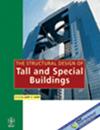具有非线性粘性阻尼机构的摆减振器
IF 1.3
3区 工程技术
Q3 CONSTRUCTION & BUILDING TECHNOLOGY
引用次数: 2
摘要
单摆减振器作为最常见的减振器模型之一,在大振幅的振荡中会出现非线性行为,在这种情况下,它们不够有效,更容易失去稳定性。为了克服这些缺点,引入了一种包括两个非线性元件的互补阻尼机构。除了普通的线性粘性阻尼器外,还利用阻尼机构来控制动态结构的振荡,该结构暴露在比优化中考虑的更强烈的激振力下。换句话说,它们使这个系统在面对比预设条件更强的激励时更加稳健和稳定。该机构的互补元件被提出,以提供各种可能的模型的适当近似,这些模型可以用作实际的非线性阻尼机构。借助谐波平衡法和更精确的三角函数近似,可以精确地获得非线性控制方程的稳态解。为了增强这种机制的影响,除了传统的目标函数外,还对复合目标函数进行了优化。这项研究解释了这种机制如何能够在更宽的激励强度范围内提高摆减振器的鲁棒性和稳定性。还研究了作为多自由度(MDOF)系统的N层剪切结构的这种吸收器的性能。本文章由计算机程序翻译,如有差异,请以英文原文为准。
Pendulum vibration absorber with a nonlinear viscous damping mechanism
Simple pendulum vibration absorbers, as one of the most common models of absorbers, experience nonlinear behaviors in the large amplitude of oscillations, and under such conditions, they are not effective enough and are more prone to lose their stability. To overcome some of these drawbacks, a complementary damping mechanism including two nonlinear elements is introduced. Alongside the ordinary linear viscous damper, a damping mechanism is also utilized to control the oscillations of the dynamic structure exposed to the excitation forces more intense than the ones considered in the optimization. In other words, they make this system more robust and stable in the face of excitations stronger than the presupposed conditions. The complementary elements of this mechanism are proposed to offer an appropriate approximation of various likely models which can be used as practical nonlinear damping mechanisms. The steady‐state solutions of the nonlinear governing equations are achieved with pinpoint precision with the help of the harmonic balance method and more precise approximations of trigonometric functions. To enhance the impacts of this mechanism, optimization is performed for a compound objective function in addition to the conventional one. This study explains how such mechanisms are capable of contributing to the higher robustness and stability of pendulum vibration absorbers under a wider range of excitation intensities. The performance of this absorber is also studied for an N‐story shear structure as a multidegree of freedom (MDOF) system.
求助全文
通过发布文献求助,成功后即可免费获取论文全文。
去求助
来源期刊
CiteScore
5.30
自引率
4.20%
发文量
83
审稿时长
6-12 weeks
期刊介绍:
The Structural Design of Tall and Special Buildings provides structural engineers and contractors with a detailed written presentation of innovative structural engineering and construction practices for tall and special buildings. It also presents applied research on new materials or analysis methods that can directly benefit structural engineers involved in the design of tall and special buildings. The editor''s policy is to maintain a reasonable balance between papers from design engineers and from research workers so that the Journal will be useful to both groups. The problems in this field and their solutions are international in character and require a knowledge of several traditional disciplines and the Journal will reflect this.
The main subject of the Journal is the structural design and construction of tall and special buildings. The basic definition of a tall building, in the context of the Journal audience, is a structure that is equal to or greater than 50 meters (165 feet) in height, or 14 stories or greater. A special building is one with unique architectural or structural characteristics.
However, manuscripts dealing with chimneys, water towers, silos, cooling towers, and pools will generally not be considered for review. The journal will present papers on new innovative structural systems, materials and methods of analysis.

 求助内容:
求助内容: 应助结果提醒方式:
应助结果提醒方式:


